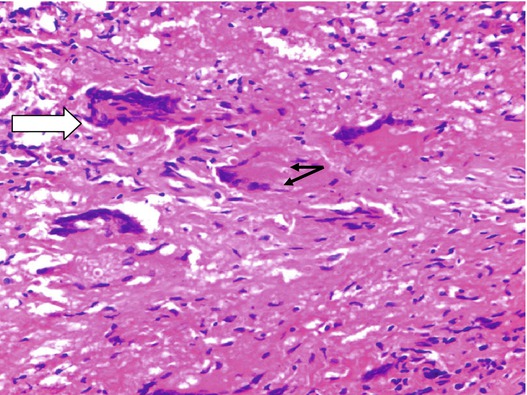Fig. 1
PAS-stained sections showing broad aseptate fungal hyphae (arrows) infiltrating the vessel wall causing a thrombus
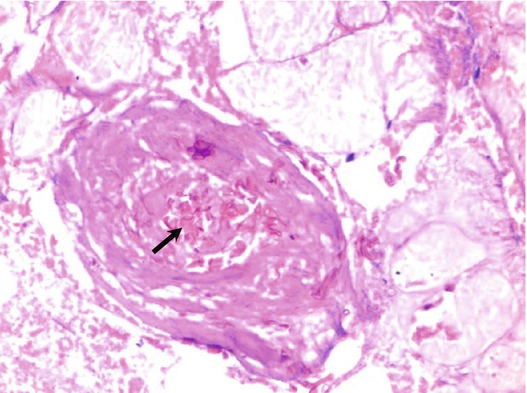
Fig. 2
PAS-stained section showing infarcted adipose tissue with broad aseptate fungal hyphae (arrow) infiltrating into the lumen on the vessel causing thrombus
These fungi, having once invaded the vessels, disseminate rapidly in fulminant fashion, extending to intracranial spaces, carotid artery, etc. and prove fatal in a very short time. Rapid diagnosis and prompt treatment may save at least some of these patients.
Histopathologists involved in diagnosis of such cases should be alerted to the possibility of acute invasive fungal infection. Intraoperative frozen section examination may save considerable time in diagnosis. If intraoperative frozen section examination facility is not available and if the primary physician/surgeon communicates to the pathologist of the clinical suspicion of invasive fungal sinusitis, then routine processing may be done in rapid fashion and the result promptly communicated to the treating physician without delay.
Once the possibility of fungal infection is considered, frozen section diagnosis should not be difficult. Vascular invasion, infarction of the tissue, and presence of fungi are not difficult to identify. Fungi can be identified even on Toluidine blue stain or H&E staining. Mucor species which is most often involved in acute fulminant processes can be identified by broad (10–15 μm wide) ribbon-like aseptate fungal hyphae which fold on themselves and branch at right angles (Figs. 3, 4, and 5), while Aspergillus species which also may cause acute invasive fulminant process (Figs. 8 and 9) appears as narrow (2–5 μm wide) septate acutely branching fungal hyphae (Figs. 7 and 8).
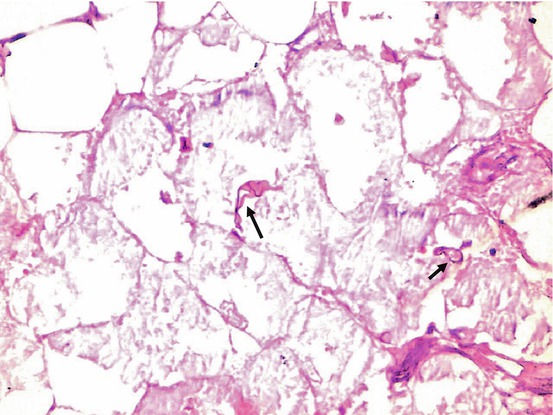
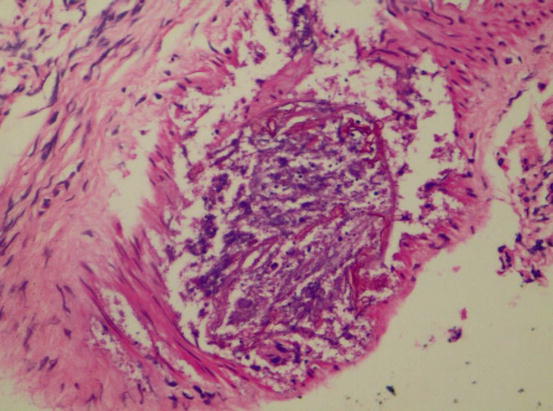
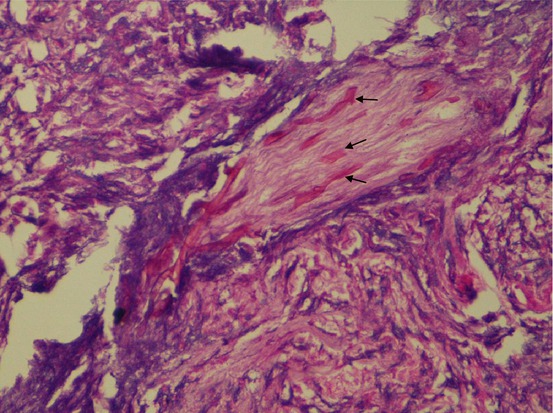

Fig. 3
H&E stain, original magnification 400× showing infarcted fat tissue with broad aseptate fungal hyphae (arrows) folding on themselves with characteristic features of mucormycosis

Fig. 4
H&E stain (original magnification 400×) fungal hyphae of Mucor in thrombosed blood vessel

Fig. 5
H&E stain (original magnification 400×) showing fungal hyphae of Mucor (arrows) in vascular lumen
Chronic Invasive Fungal Rhinosinusitis (Fig. 6)

Fig. 6
H&E stain showing chronic inflammatory exudate with fungi (arrow) within the exudate
In these cases, there is usually destruction of the tissue with chronic abscess-like inflammatory reaction with presence of fungal elements within the exudate. There is usually nothing – either clinically or histologically to alert the pathologist about the possibility of fungal etiology and hence the diagnosis may be missed. Constant alertness and a high level of suspicion of fungal etiology in all such cases irrespective of the underlying disorders helps in identifying such cases. Unlike the neutrophil-rich, highly necrotic, and angiotrophic process seen in acute invasive fungal sinusitis, there is a low-grade mixed cellular infiltrate in affected tissues [9]. Usually this occurs in diabetics, is slowly progressive, and elicits limited inflammation.
Chronic Granulomatous Fungal Rhinosinusitis
Other terms for this condition include “indolent fungal sinusitis” and primary paranasal granuloma. Published cases include those from Sudan (due to Aspergillus flavus) and St Louis, MO [10, 11]. Patients invariably have no predisposing factors, and the lesion usually presents as a destructive process raising the suspicion of malignancy. There is often destructive growth eroding in to the orbit. Histologically this presents as chronic granulomatous process with non-necrotizing granuloma composed of clusters or sheets of foreign-body-type multinucleated giant cells with fair number of eosinophils in the background. The combination of sheets/clusters of foreign-body-type multinucleated giant cells with eosinophils in the background should be enough to alert the pathologist about possibility of fungal (mainly Aspergillus flavus) disease. Close look at the giant cells even in frozen sections or paraffin sections stained with hematoxylin and eosin stain should reveal short well-stained or shadow-like unstained fungal hyphae in the cytoplasm of the giant cells (Fig. 7). GMS stain (Fig. 8) and PAS stain (Fig. 9) also reveal the characteristic features of the fungus within the giant cells. Tuberculosis does not commonly involve the paranasal sinuses. Also concomitant stains for mycobacteria are negative. Hence, any granulomatous disease causing destruction of bone that initially clinically presents as a malignancy in young immunocompetent patients should alert the pathologist to the possibility of chronic invasive granulomatous sinusitis.
